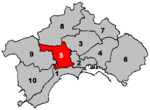Santa Maria del Soccorso all'Arenella
17th-century Roman Catholic church buildings in ItalyBaroque architecture in NaplesChurches in Naples

Santa Maria del Soccorso all’Arenella is a parish church, located in the Piazzetta Arenella in the Rione of Arenella of Naples, Italy. Tradition holds that this church was the parish church for Salvatore Rosa in Naples.
Excerpt from the Wikipedia article Santa Maria del Soccorso all'Arenella (License: CC BY-SA 3.0, Authors, Images).Santa Maria del Soccorso all'Arenella
Via Giacinto Gigante, Naples Arenella
Geographical coordinates (GPS) Address External links Nearby Places Show on map
Geographical coordinates (GPS)
| Latitude | Longitude |
|---|---|
| N 40.8534 ° | E 14.231545 ° |
Address
Chiesa di Santa Maria del Soccorso all'Arenella
Via Giacinto Gigante
80128 Naples, Arenella
Campania, Italy
Open on Google Maps







